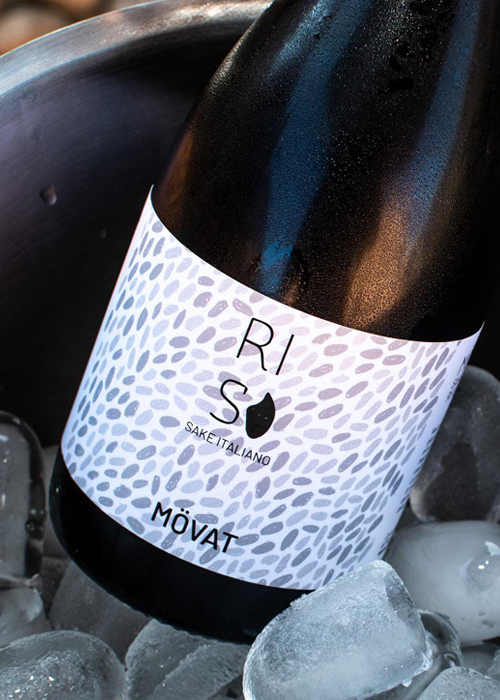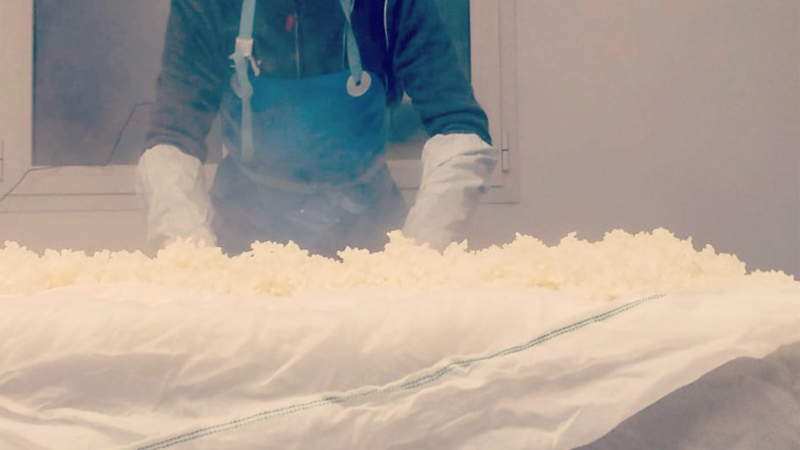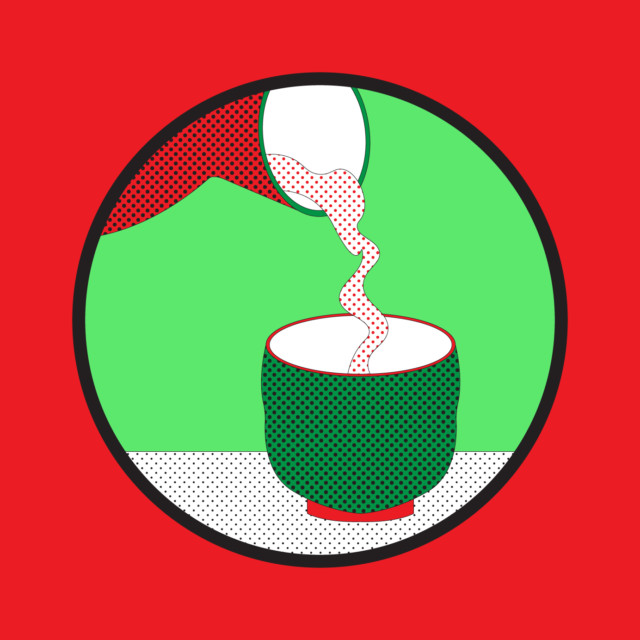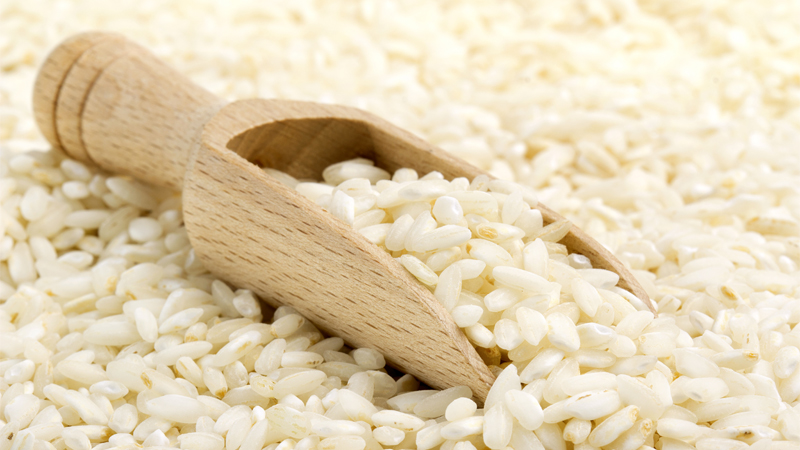When Misal Memeo and Nicola Coppe decided to create a line of Italian sake, they knew they’d have some obstacles to overcome. First, no one had ever made a truly Italian sake before. Second, how could they make a product that would both appeal to the Italian palate and stand out in a market saturated with wine and craft beer? And third, neither of them really knew how to make sake. Luckily, those obstacles didn’t stop them from launching Riso Sake, the first and only Italian sake using koji, in 2019. Combined with pristine mountain water from the Dolomites, Riso Sake produces a markedly Italian fermented rice wine: dry, easy-drinking, with refreshingly high acid for food pairing, reminiscent of starchy risotto with a sake accent. But none of it would have been possible without a very important ingredient: carnaroli rice.
The Caviar of Rice
It all started back in 2018, when Memeo was living in Rome but missing the foods of his hometown, Pavia. He satisfied his yearning by studying them, leading him to stumble on the scientific name of Italy’s beloved carnaroli rice, Japonica Oryzae. Prized for being exceptionally rich in sugars and starches, carnaroli originally came to Italy from Japan, as the name implies, but evolved through the years to adapt to Italian gastronomic uses, particularly in risotto, which depends on its coveted starches to create rich creaminess. From there, it didn’t take much to connect the dots. Memeo saw how the best Japanese sakes began with specialty rice grains that share the same features that earn carnaroli its reputation as the caviar of rice. Carnaroli is popular in Italian kitchens because as you cook it, the starches release, creating a buttery mouthfeel and a saucy binder for saffron (as in Milanese risotto), foraged mushrooms, truffles, and the like. Sake-making applies the same principle during the fermentation process: The yeast plays with the sugars in the rice to yield alcohol. More starch yields more glycerin, another byproduct of the process, which adds a silkiness to the mouthful, and thus creates a drink with a round, luscious body.
“I immediately had the idea of making sake,” Memeo says of his experience in Rome, envisioning it as a way to reconnect the rice to its history. The organic chemist, who traded in his lab coat for venture capital, had a small problem, though: He had no idea how to make sake. But he knew just who to reach out to: Coppe, an award-winning brewmaster who specializes in wild fermentations and yeast ranching, and paved the way for sour beers in Italy. It didn’t take much for Coppe to join, creating a partnership between the two. “When Misal pitched the project, I jumped to the challenge. Brewing sake is deeply different from making beer. Plus there was nobody brewing sake from carnaroli. I couldn’t say no!” Coppe exclaims.
“Nicola is hailed in the craft beer community as the master of yeasts in Italy, tinkering in the laboratory and consulting for breweries around Europe,” says Lapo Ricci, a Florence-based craft beer pub owner, of how the project intrigued industry pros like him. “So when he and Misal decided to open the first Italian sakagura (sake production site) we thought, why not trust this new experiment and support it?”
But Memeo and Coppe were primarily beer enthusiasts venturing out to planet vino and looking to Japan for inspiration. They aimed to produce a wine-like product (in approachability) with beer brewing principles by following a sake blueprint, but catering to their own Italian predilections instead of sticking to the Japanese classification system. “Since Italian rice came via the East, but evolved to meet the Italian palate, I wanted to create an Italian-style sake to pair with our cuisine,” Memeo explains.
They wanted to achieve a sense of terroir down to the water as well, sourcing it from the nearby Dolomites. “Water from the Dolomites is untreated and is without removing minerals which make the water ‘hard,’ thus lending subtle flavor nuances,” says Memeo. “Feltre (in Veneto) is one of the finest sources for Dolomite water springs and happens to be where Nicola — and our production site — lives.”

While the rice and water were decided, the pair still needed the koji mold and yeasts to create a traditional sake. “What makes sake is koji,” explains Memeo. “We’ve seen other Italian sakes on the market but they don’t use koji, so it’s essentially a rice vermouth.” Cracking the koji code was no small feat for these pros, even if they’d mastered myriad yeasts, molds, and fermentation in other expressions for brews like sour beer. “Understanding the way the koji worked with carnaroli was not easy. Sometimes the sake reeked of old furniture, other times like rotten cheese,” says Memeo. They had to fine-tune the process to get the best out of the koji and the rice itself, nailing the timing and temperature. “Nicola is in the kura day and night when brewing sake to make sure it’s sleeping, growing, and feeding properly,” Memeo jokes, “like tending to a newborn!”
But while the Japanese model sticks strictly to koji and prioritizes texture over acidity, resulting in higher alcohol and a more bouquet-driven drink, Coppe and Memeo wanted to create something approachable for those Italians not accustomed to sake.
“Italians generally are familiar with sake but often think of it as a singular warm beverage with sushi,” explains Sake sommelier Duccio Mazzetti of Kawaii sake bar in Florence, “when in reality sake takes on many forms and is fascinatingly versatile for food pairings for those curious enough to deviate from usual local wines.”
Deviating From Tradition
Riso Sake has four sake expressions in production, all premised on various isolated yeasts used in addition to koji, and are named accordingly. The move to deviate from naming after Japanese styles was intentional, to eliminate confusion with Italians over complex nomenclature. They use familiar products to achieve this, like yeasts normally used in Prosecco production for their sparkling Movat, or American hops and beer yeasts for the fruitier notes in their HOPe.
https://www.instagram.com/p/CDBcUTOqiko/
Their Harmoniae (with notes of pear, peaches, and almonds) and Vero (rugged, spicy, and full-bodied) expressions hew closer to Japanese sake, but the dry, full-bodied brews keep their Italian identity — and set themselves apart from traditional sake — with the flavor and fragrance of the rice. “We really did our best to let the carnaroli talk,” says Memeo. Movat, Riso’s sparkling sake, is made using the traditional méthode Champenoise, creating a fermenter’s wildest gourmet dream. It slams your palate with crisp acidity, then moves into toasted brioche territory to signal it was bottle-fermented and finishes with a smooth rice richness reminding you it is actually sake, while still honoring the distinct Italian risotto grain.
Riso recently debuted a seasonal offering, Rubus Idaeus, infused with raspberries plucked from the Dolomites, considered to be the best region for these berries. And a sixth will involve infusing a sparkling sake with lemons from the Amalfi.

Expanding a Growing Audience
Launching such a food-friendly product into a market replete with (and clamoring for) wine and craft beer would be difficult in the best of times. But adding another flaming hoop to its obstacle course, Riso Sake’s launch coincided with the start of the pandemic and the shuttering of restaurants.
The niche product planned to rely heavily on serviced dining establishments like the country’s few fusion restaurants and sake delivery services. Instead, their market came from word of mouth, starting with the beer geeks like Ricci who loyally followed Coppe’s sour beers, then spread to various other communities of drink nerds. Their current production is modest at 12,000 bottles per year, but growing to encompass culinary products made with sake production byproducts.
Soon they hope to snare another audience: the eco-conscious. Sake brewing generally creates substantial waste in the rice polishing, favoring intact, pristine grains and tossing many broken ones. But Memeo and Coppe have a zero-waste vision in their production.
Riso Sake transforms the rice dust created from polishing into rice flour, uses the husks as part of the sake filtering process, and feeds the koji mold with broken grains. The spent lees from making Movat, called sake kasu, are considered gold for marinating meat and they are developing a line of culinary products, such as local cheeses aged in a sake kasu rub, and collaborating with chefs in the area on sake kasu dry-aged steaks. In the future, Memeo and Coppe hope to use the sake kasu for distilling grappa sake or shochu. And the pair is also working on isolating the kojic acid (produced via sake fermentation) from their byproducts to launch beauty products. “There’s a legend that those with the most youthful skin work in sake cellars since it’s brimming with kojic acid,” says Memeo.
Aged cheeses and beauty products aside, though, the pair’s goals for Riso Sake are much bigger. “We want to disrupt the sake world,” they profess. Memeo’s inspired imagination and innovative ideas, combined with Coppe’s creativity and expertise with fermentation, shine in Riso’s incredible, unrivaled drinks. But the pair views drinks as just the beginning of what they can do at the intersection of Japanese tradition and Italian innovation.

